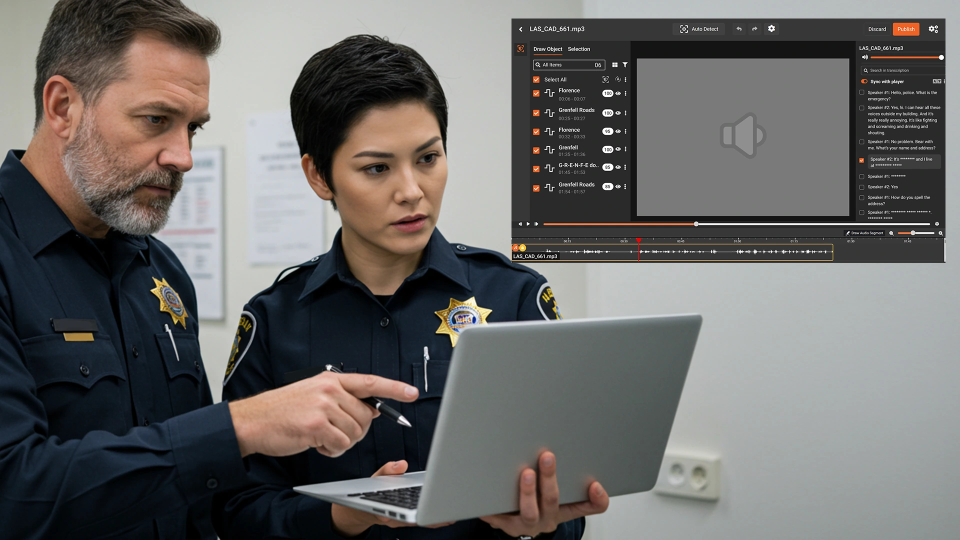How Mass Tort Firms Automate Medical Record Redaction
by Zain Noor, Last updated: December 5, 2025
.webp)
Key Takeaways
- Tort filings have surged by nearly 20% in 2024, increasing pressure on mass tort law firms to handle large volumes of medical records efficiently.
- Manual redaction methods are no longer sustainable due to high document volume, human error, and compliance risks.
- Automated redaction uses AI and OCR to identify and redact PHI and PII from thousands of documents with speed and accuracy.
- AI-driven systems allow custom redaction patterns, bulk processing, and human-in-the-loop validation for quality assurance.
- Automation cuts redaction time by up to 90% while maintaining HIPAA and GDPR compliance.
- Beyond redaction, AI adds intelligence with document summarization, searchable redacted data, and insight generation.
- VIDIZMO Redactor combines automation, summarization, and search capabilities into one secure, scalable solution for legal teams.
- Adopting automation enables law firms to improve accuracy, reduce costs, and accelerate case preparation in high-volume mass tort litigation.
The latest Lex Machina 2025 Torts Litigation Report revealed a sharp rise in tort filings across the United States. Between 2023 and 2024, tort cases increased nearly 20% compared to the previous two years, with record verdicts totaling over $980 million in damages awarded to claimants. Federal courts reported the highest number of lawsuits for motor vehicle injuries and premises liability on record, underscoring a broader shift toward higher litigation volumes and larger jury awards.
Mass tort litigation brings an ongoing flow of medical records, intake forms, and discovery documents that must be processed quickly and securely. Each document contains sensitive personal and medical information that must be properly redacted before attorneys can review or share it.
As caseloads grow and evidence becomes more complex, traditional manual redaction methods struggle to keep pace. Manual review is slow, inconsistent, and prone to human error, making it difficult for legal teams to meet deadlines while maintaining compliance.
To overcome these challenges, many mass tort law firms are now adopting automated medical record redaction. AI-powered tools streamline the entire process by identifying sensitive information, applying accurate redactions, and preparing documents for review far more efficiently than manual workflows
The Redaction Bottleneck in Mass Tort Litigation
Mass tort cases often begin with a flood of client documents: medical reports, billing statements, hospital correspondence, and intake questionnaires. These records are often sourced from multiple healthcare providers, scanned in varying quality, and structured differently.
Before these documents can enter the discovery process, law firms must:
- Remove PII and PHI such as Social Security numbers, full dates of birth, and patient IDs
- Ensure HIPAA compliance and avoid over-redaction
- Maintain document integrity for admissibility
This process, when done manually, consumes hundreds of hours. Staff use tools like Adobe Acrobat or Nitro PDF, often facing system crashes, unsearchable scans, and human oversight errors.
The outcome is predictable delays, rising costs, and compliance exposure.
Why Manual Redaction No Longer Fits Modern Litigation
Manual workflows were manageable when firms handled a few cases at a time. Today, mass tort cases generate data volumes similar to enterprise-scale investigations.
Manual redaction breaks down because:
- Performance limits: PDF editors crash with multi-thousand-page files.
- Human fatigue: Reviewing repetitive patterns across hundreds of pages leads to missed redactions.
- Inconsistency: Each paralegal applies slightly different redaction logic.
- Cost inefficiency: Firms must either hire temporary staff or divert litigation support from strategic tasks.
Even worse, once redactions are applied, there’s no intelligence extracted. The data becomes “clean,” but not useful.
Automated Redaction: A Data-Driven Solution
Automated redaction systems use natural language processing (NLP) and pattern recognition to detect and redact sensitive information instantly. They can analyze thousands of pages, identify patterns such as dates, names, medical IDs, or SSNs, and apply redactions in a fraction of the time a human team would need.
Key features that transform efficiency include:
- AI-driven PII/PHI detection: Automatically identifies sensitive data based on pre-trained and custom patterns.
- Optical Character Recognition (OCR): Converts scanned and handwritten medical records into searchable, redactable text.
- Rule-based flexibility: Define specific logic like “redact DOB except year” or “mask only last 4 digits of SSN.”
- Bulk processing: Handle hundreds of records simultaneously while maintaining file integrity.
- Human-in-the-loop validation: Combine automation speed with human judgment for accuracy.
For law firms managing thousands of plaintiff files, automation turns redaction from a reactive step into a scalable process.
The Real-World Impact: Time, Accuracy, and Compliance
- Up to 90% reduction in redaction time for high-volume document workflows.
- Higher consistency and accuracy, reducing the risk of overlooked PII.
- Reduced dependency on contract reviewers or third-party services.
- Improved compliance posture, ensuring every document meets HIPAA, GDPR, and discovery standards.
This operational efficiency doesn’t just save time, it gives firms a competitive edge. Faster redaction means faster review, quicker filings, and earlier settlement readiness.
From Redaction to Intelligence: The Next Evolution
Once redaction is automated, the next question becomes: What else can we learn from these documents?
The true value of AI lies in enabling legal teams to extract insights from the same data they are redacting. AI-driven systems can now:
- Summarize medical records to highlight key findings, diagnoses, and timelines.
- Identify missing or duplicate records across thousands of documents.
- Enable full-text search across redacted datasets to quickly locate relevant details.
- Generate structured case summaries that support attorneys in discovery and settlement preparation.
This is where the shift happens from document management to document intelligence.
VIDIZMO Redactor: Redaction and Intelligence in One Platform
VIDIZMO Redactor brings together automated redaction, AI summarization, and intelligent search—built for law firms handling sensitive, high-volume evidence.
With VIDIZMO Redactor, legal teams can:
- Automate HIPAA-compliant redaction of PII and PHI from thousands of medical records.
- Leverage built-in OCR to process scanned or image-based files with high accuracy.
- Summarize medical documents automatically, generating case-ready insights in minutes.
- Search through redacted datasets to locate specific terms, patients, or case identifiers without exposing private data.
- Integrate securely with SSO systems for controlled user access and compliance.
- Scale usage through flexible, time-based subscriptions without upfront commitments.
By combining redaction, summarization, and search, VIDIZMO Redactor transforms document-heavy workflows into a searchable, intelligent data ecosystem.
It’s not just about hiding information anymore’s about managing it smarter.
People Also Ask
What is medical record redaction in law firms?
Medical record redaction is the process of removing sensitive personal information, such as PHI or PII, from legal evidence before it is shared or submitted for discovery.
Why is automation essential for medical record redaction?
Automation reduces human error, improves accuracy, and speeds up document processing for law firms managing thousands of records.
Is automated redaction HIPAA compliant?
Yes. Reliable automated redaction tools ensure full HIPAA compliance by detecting and masking PHI across all documents.
How does OCR improve redaction workflows?
OCR converts scanned or image-based records into searchable text, allowing AI systems to identify and redact sensitive information more efficiently.
What are the benefits of using AI for document summarization?
AI-generated summaries help attorneys quickly understand long medical documents, identify missing data, and prepare cases faster.
Can redacted documents still be searched?
Yes. With AI-powered systems like VIDIZMO Redactor, redacted documents remain searchable without exposing private data.
How can law firms scale redaction operations efficiently?
Automation allows firms to process large volumes without increasing staff, ensuring consistency and cost efficiency.
Conclusion
Mass tort law firms can no longer afford to treat redaction as a manual afterthought. Automation allows them to manage scale, meet compliance standards, and build intelligence into their workflows.
VIDIZMO Redactor enables this transformation. It replaces hours of manual effort with precision automation and gives legal teams the ability to search, summarize, and act on their data with confidence.
Start your free trial of VIDIZMO Redactor or explore how it can streamline your legal evidence workflows today.
Jump to
You May Also Like
These Related Stories

How to Automate PHI Redaction in Medical Records for Clinical Research

Manual Redaction vs AI Redaction for Police Agencies
.webp)

No Comments Yet
Let us know what you think